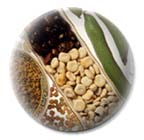- Home
- Introductions

|
Vegetable Seed Production
IntroductionWhat is a Vegetable? Most definitions of vegetables are not botanically based. These definitions
are based on usage and are rather arbitrary. A common definition is: A
vegetable is a herbaceous plant, or portion of a plant, that is eaten
whole or in part, raw or cooked, generally with an entree or in a salad
but not as a dessert. Of course there are exceptions to this. Rhubarb
and melons are both used commonly as desserts. Since "vegetable"
is not a botanical term, some vegetables botanically speaking are also
fruits. For example, tomato, pepper, bean, and cantaloupe botanically
are fruits but because of the way they are used and produced and for historical
reasons they are considered to be vegetables. Fruit is often used in a
strictly botanical sense to describe a ripened ovary containing seeds
together with adjacent parts that are eaten at maturity. Confusingly,
there is also a definition of fruit that is also based on usage and is
less botanically oriented. By this definition, a fruit is simply a sweet
and edible plant structure consisting of a fruit (in the botanical sense)
or a false fruit of a flowering plant usually eaten raw or as a dessert.
Many true or botanical fruits are not sweet such as tomato, bean etc.
and these are the ones commonly referred to as vegetables. Vegetable crops
are usually considered high value crops that are intensively managed and
should be contrasted with agronomic crops, which are extensively grown
and less intensively managed. Wheat, cotton, and rice are all considered
agronomic crops. Some crops like Irish potato may be considered as either
vegetable or agronomic crops. Some agronomic crops such as tobacco are
intensively managed and of high value but are considered agronomic for
historical reasons. Corn and soybeans can be either agronomic or vegetable
crops depending on the cultivars grown, the time of harvest, and the end
use of the commodity.
A major problem occurs with the classification of botanic variety. This confusion in nomenclature is due to the fact that molecular genetic studies have shown that major morphological differences may be caused by single or few genes and therefore do not warrant classification into separate botanical varieties. An example of this would be cauliflower (family: Brassicaceae, genus: Brassica, species: oleracea, botanical variety: botrytis, cultivar: Snowball Y). Molecular genetic studies by Elliot Meyerowitz and other have shown that the a single gene controls the development of undifferentiated flower primordial (curd) and if this gene is expressed in broccoli or cabbage they also produce a curd like cauliflower. Over the past 15 years, there has been a growing consensus among plant biologists that it is invalid to subdivide Brassica species into distinct botanical varieties. Obviously cauliflower is different from cabbage to make light of these horticultural differences, the Index of Garden Plants by Mark Griffiths, 1994, Timber Press, Portland, Oregon, USA classifies cauliflower as Brassica oleraceae Group Botrytis rather than botanical variety botrytis, which is more common in the older literature. Therefore, the term Group (gp.) is used for convenience by horticulturists to show groups of horticultural significance within a species that were previously classified as separate varieties. Taking the cauliflower example a step further, Snowball is a particular cultivar of cauliflower, Y is a particular strain of Snowball and different production fields of Snowball could be designated as individual lots. A Snowball type would refer to cultivars with the same basic characteristics as Snowball (e.g. a early maturing cultivar that does not require vernalization to develop a curd) and would include all the various strains of Snowball. For example, a cauliflower grower may ask a seed salesman if a cultivar is a "Snowball type" even though it may have a different cultivar name. What is a seed?Although a few vegetables like potatoes and sweet potatoes are vegetatively propagated, the vast majority of vegetables are established from seeds. One definition of a seed is "an immature plant in an arrested state". Seeds are one of the true wonders of nature because of their desiccation tolerance, small size, storability, ability to sense the surrounding environment, rapid growth, and persistence. Using quality seeds is a prerequisite for successful vegetable production. There are several classifications of seeds that are used to describe how seeds are pollinated. Open-pollinated Self versus Cross-pollinated Crops Pure Line Hybrids Most agriculturists recognize it is unwise to cut costs by saving a few dollars on seeds of a substandard cultivar or by purchasing lower quality seeds. Cutting corners on seed costs will generally end up costing even more because of lost revenues from lower yields. Like so many other areas of agriculture, seed handling practices have changed dramatically over the years. For generations, farmers saved their own vegetable seeds and maintained their own cultivars. More recently, seeds were often obtained from local agricultural retailers. Today, vegetable growers are faced with a wide array of seed treatments and cultivars that may be purchased from sources around the world.
|